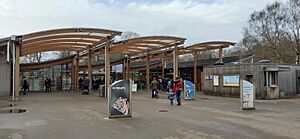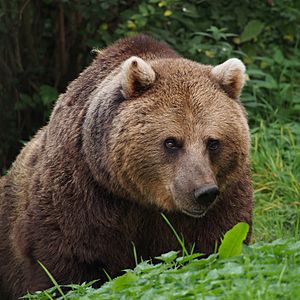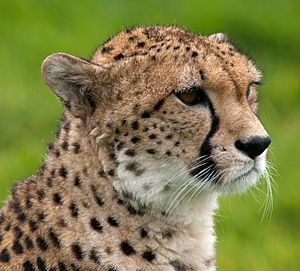Whipsnade Zoo facts for kids

Main entrance to Whipsnade Zoo
|
|
| Date opened | 1931 |
|---|---|
| Location | Whipsnade, near Dunstable, England |
| Land area | 600 acres (2.4 km2) |
| Coordinates | 51°50′59″N 000°32′39″W / 51.84972°N 0.54417°W |
| No. of animals | 3,626 (2018) |
| No. of species | 209 (2018) |
| Annual visitors | 648,945 (2019) |
| Memberships | BIAZA, EAZA, WAZA |
| Major exhibits | Lions of the Serengeti, Passage through Asia, In with the Lemurs |
Whipsnade Zoo is a huge animal park located in Whipsnade, near Dunstable, England. It's also known as ZSL Whipsnade Zoo. This amazing zoo is one of two owned by the Zoological Society of London (ZSL). ZSL is a charity that works hard to protect animals and their homes all over the world. The other zoo they own is London Zoo in Regent's Park, London.
Contents
Exploring Whipsnade Zoo
Whipsnade Zoo is massive, covering about 600 acres. You can even spot it from far away because of the Whipsnade White Lion. This is a giant lion shape carved into the side of the Dunstable Downs hills. It's right below where the white rhinos live!
Because the park is so big, you can choose how to get around. You can walk, or you can drive your own car between the different animal areas. There's even a special 'Asian' section where some animals roam freely around the cars. If you prefer, you can ride the "Jumbo Express" train, which is a fun way to see the park.
Whipsnade Zoo is the biggest zoo in the UK. It's also one of Europe's largest wildlife conservation parks. It's home to over 3,600 animals, and many of them are endangered in the wild. Most animals live in large enclosures. However, some animals like peacocks, Patagonian maras, and red-necked wallabies wander freely around the park.
Zoo History and Growth
The Zoological Society of London (ZSL) started in 1826. Sir Stamford Raffles created it to help protect animals and their habitats worldwide. This led to the opening of London Zoo.
Almost 100 years later, Sir Peter Chalmers Mitchell, who was in charge of ZSL, had an idea. He visited the Bronx Zoo in the United States and wanted to create a similar large conservation park in Britain.
In 1926, ZSL bought Hall Farm, an old farm on the Dunstable Downs. This spot was about 30 miles north of London. They built fences, roads, and planted trees to get it ready.
The first animals arrived at the park in 1928. These included pheasants, junglefowls, muntjacs, llamas, wombats, and skunks.
Whipsnade Park Zoo officially opened on Sunday, May 23, 1931. It was the first open zoo in Europe that was easy for the public to visit. It was an instant hit! Over 38,000 people visited on the very next day. The brown bear enclosure you see today is one of the original parts of the zoo.
In 1932, the zoo got even more animals. They bought a collection from a traveling animal show that had closed down. Some of the larger animals even walked to the zoo from Dunstable station!
The famous white lion hill figure was finished in 1933. It was refreshed in 2018 and again in 2025 for the zoo's 94th anniversary.
Whipsnade During World War II
During the Second World War, Whipsnade Zoo became a safe place for animals from London Zoo. Famous giant pandas like Ming, Sung, and Tang stayed there for a while. They were later sent back to London to help cheer people up.
In 1940, 41 bombs fell on the park. Luckily, there was not much damage to the zoo buildings. Some of the ponds in the park are actually old bomb craters from this time. Sadly, a goose and a young giraffe named Boxer died because of the bombings. The giraffe ran herself to exhaustion from fright.
New Additions and Updates
In 1996, a new, bigger home for the elephants opened. The old elephant house, built in 1935, is still at the zoo. It's now home to the zoo's lemurs.
In the early 2000s, Whipsnade added many new exhibits. These included Lions of the Serengeti (2005) and a walk-through lemur area (2007). The Rhinos of Nepal exhibit opened in 2007. Cheetah Rock opened in 2008, and a sloth bear exhibit followed that same year. Wild Wild Whipsnade opened in 2009. The Café on the Lake was updated in 2008 and is now called the Base Camp Restaurant.
In May 2009, a special goat named William Windsor (or Billy) retired to the zoo. Billy was a mascot for the British Army's Royal Welsh regiment for eight years.
In April 2024, the new Monkey Forest habitat opened. It's a 2-kilometer walk where visitors can see the Passage through Asia from a different view. It also has two new mixed-species enclosures for langurs, macaques, babirusa, and anoa.
Amazing Animal Exhibits
In with the Lemurs
This exhibit is near the zoo entrance. "In with the Lemurs" is a walk-through area where you can see ring-tailed lemurs up close. There's also an extra viewing spot.
Aquarium and Butterfly House
The Butterfly House opened in 2016. It's home to many kinds of butterflies and dwarf crocodiles. You can walk through the exhibit and see butterflies flying all around you. It also has one of the world's largest moths, the atlas moth.
In 2019, the aquarium opened in the same building. It has stingrays, panther chameleons, elephantnose fish, and many other interesting water creatures.
Passage Through Asia
Passage Through Asia is a huge open area. There are no fences between visitors and the animals here. You can only enter this area by driving your car through it or riding the Jumbo Express train. This paddock is home to herds of Bactrian camels, barasinghas, fallow deer, sika deer, Père David's deer, and yaks.
Lions of the Serengeti
This exhibit opened in 2005. It was once home to a pride of seven African lions. The pride included two adult females, Mashaka-Lia and Kachanga, and three younger males named Neo, Toto, and Max. There was also a younger female named Kia. The four younger lions were born in April 2006.
Sadly, Toto passed away in October 2021 at 15 years old due to illness. In December 2021, Neo, Kia, and Max were humanely euthanized. This was because age-related conditions were causing them pain. The Lion habitat is currently closed while the zoo looks for a new breeding group.
In early 2022, Whipsnade temporarily housed five lions from Africa Alive! Suffolk. Their enclosure was damaged by Storm Eunice.
From May 2022, the zoo housed Khari, a male lion from Blackpool Zoo. Khari returned to Blackpool Zoo in the summer of 2023. Whipsnade is still searching for a suitable breeding group. Two new lionesses from Belgium and a male from Germany joined the zoo's collection in 2025.
Sea Lion Splash
This used to be the zoo's Dolphin Pool. Sea Lion Splash was a daily show where the zoo's three trained California sea lions performed tricks. The sea lions were two females named Bailey and Lara, and a male named Dom. In June 2015, Dom and Bailey had a male sea lion pup named Oscar. In February 2021, the zoo's sea lions moved to Yorkshire Wildlife Park.
Elephant Herd
ZSL Whipsnade Zoo has a herd of seven Asian elephants. The herd includes cows Kaylee, Lucha, Karishma, Donna, Elizabeth, and Nang Phaya. The bull elephant, Ming Jung, arrived from Antwerp in November 2019. He is part of a special program to help endangered species.
Their paddock is seven acres big. It has three pools, mud wallows, and dust baths for the elephants. One of the female elephants, Karishma, and her pregnancy were shown in an ITV show called The Zoo. Another female calf was born during Elizabeth II's 90th birthday celebrations and was named in her honor. The elephant herd moved into a new indoor facility, the Centre for Elephant Care, which opened in April 2017.
Rhinos of Nepal
Opened in February 2008, Rhinos of Nepal is home to four Indian rhinoceroses. Their names are Hugo, Beluki, Behan, and a young male named Bali. Bali was born to Behan in September 2015. The building for the rhinos is designed to be good for the environment. It uses rainwater for the pools and solar energy to heat them. The barriers are made from recycled railway sleepers instead of metal bars.
Birds of the World
This is a daily educational show. Keepers present different bird species. The birds show off their natural abilities to the visitors.
Cheetah Rock
Cheetah Rock opened in 2008. This exhibit is home to a group of cheetahs. There are also displays that teach visitors about ZSL's cheetah conservation project in Tanzania. The cheetahs at Whipsnade are Sudan cheetahs from Northeast Africa. The zoo is now home to three male cheetahs who moved from Ireland in 2022.
Hullabazoo Farm
This area is mostly for children. It has farm animals like turkeys, llamas, alpacas, cows, silkie chickens, horses, miniature ponies, donkeys, rabbits, guinea pigs, and goats. Many of these animals roam freely. Hullabazoo Farm was also once home to a female Bennett's wallaby named Pip. She was abandoned by her mother and raised by the keepers.
Wild Wild Whipsnade
Wild Wild Whipsnade opened in 2010. This exhibit features several animal species that lived in the wild in Britain hundreds of years ago. These include Eurasian brown bears, wolverines, Eurasian lynxes, reindeer, wild boars, and European bison.
Other Amazing Animals
Whipsnade Zoo is also home to many other incredible animals. These include Amur tigers, blesbok, Asian small-clawed otters, red pandas, great white pelicans, gemsbok, sloth bears, meerkats, aardvarks, Cape porcupines, common ostriches, shoebills, sandhill cranes, nilgai, gaurs, masai giraffes, reticulated giraffes, southern white rhinoceroses, Przewalski's wild horses, chimpanzees, American flamingos, northern rockhopper penguins, Grévy's zebras, African wild dogs, bongos, hippopotamuses, scimitar-horned oryxes, waterbucks, African penguins, and marabou storks.
Supporting the Zoo
Whipsnade Zoo and ZSL do not get money from the government. They rely on money from entrance fees, memberships, and donations. This helps them continue their important work in animal conservation.
Daily Shows and Talks
The main animal show is the 'Birds of the World' demonstration. During the summer, there are also daily talks. These include talks about lemurs, giraffe feeding, and penguin feeding.
Filming at the Zoo
Whipsnade Zoo has been a filming location for several TV shows and adverts. It was used for ITV's Primeval. It also appeared in BBC's Super Vets and a CBBC show called Brum in 1991. Jamie Oliver and Sainsbury's filmed an advert there in 2001. The BBC One show Merlin also used parts of Whipsnade for its first season.
Chimpanzee Incident
In September 2007, two chimpanzees named Koko and Jonnie escaped from their enclosure. They had moved from London Zoo. Koko followed a keeper back to the enclosure. However, Jonnie started heading towards public areas. For public safety, Jonnie was shot by the zoo's trained firearms team. The zoo stated that visitors were never in danger. They explained that using a tranquilizer might not have been fast or safe enough.









